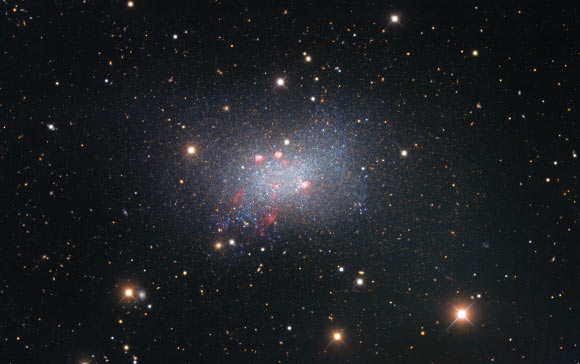Astronomers using the Nicholas U. Mayall 4-m Telescope at Kitt Peak National Observatory have captured a breathtaking photo of an irregular dwarf galaxy called Sextans B.

This image of the irregular dwarf galaxy Sextans B, taken by the Nicholas U. Mayall 4-m Telescope, features red-colored star-forming regions near the galaxy’s center; surrounding the galaxy are several bright stars that are located much closer to us in our Milky Way Galaxy, identified by the crisscross patterns created by light interacting with the structure of the telescope, as well as numerous fuzzy-looking background galaxies that appear small because they are much farther away than Sextans B. Image credit: KPNO / NOIRLab / NSF / AURA / P. Massey, Lowell Observatory / G. Jacoby / K. Olsen / C. Smith, AURA & NSF / T.A. Rector, University of Alaska Anchorage & NSF’s NOIRLab / M. Zamani, NSF’s NOIRLab / D. de Martin, NSF’s NOIRLab.
Sextans B resides approximately 4.7 million light-years away in the minor equatorial constellation of Sextans.
Also known as DDO 70, LEDA 28913 and UGC 5373, the galaxy has a diameter of 6,000 light-years.
Sextans B forms a pair with its neighboring galaxy Sextans A, and is likely a member of the Local Group of galaxies or lie just beyond it.
“With a total mass of around 200 million times the mass of the Sun, Sextans B hosts an intriguing variety of astronomical objects,” explained astronomers from NSF’s NOIRLab.
“Some of the most conspicuous are the ruby-red clouds of atomic hydrogen visible near the center of the new image.”
“These vast, glowing clouds are giving birth to brilliant new stars. Supernovae and the stellar winds from these young stars will eventually sweep aside the cool clouds of hydrogen, leaving behind clusters of stars with similar ages and properties.”
“Sextans B is one of the smallest galaxies known to contain several planetary nebulae — the outermost layers of aging red giant stars, thrown out into space at the end of a star’s life.”
In addition to Sextans B and its contents, the new image features both very distant objects and stars much closer to home.
“Faraway galaxies can be seen littering the background of this image, noticeable by their fuzzy appearance or irregular shapes,” the astronomers said.
“Meanwhile, bright stars from our own Milky Way Galaxy shine in the foreground.”
“Several of the bright nearby stars are surrounded by conspicuous diffraction spikes — the prominent crisscross patterns created by light interacting with the structure of a telescope.”







